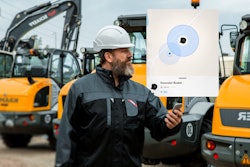
When it comes to asset management technology, it’s taken a while to get the construction industry out of the Stone Age. But it really is happening.
For both construction companies and contractors alike, spreadsheets and whiteboards have traditionally been the go-to tools for managing both rented and owned assets, from excavators to aerial lifts to track loaders and everything in between. There were a number of reasons (excuses, really) to explain their hesitation to embrace the available technology:
- “We’ve always done it this way.”
- “It’s too expensive. We already work on razor-thin margins.”
- “It’s too complicated to learn.”
However, as construction firms and independent contractors have begun to realize the benefits that these asset management tools provide–cost savings, increased productivity and proper resource allocation, to name just a few–they have warmed up to the idea.
In 2019, 22% of general contractors reported using “equipment tagging” to track and manage their assets, a number that is projected to increase substantially to 42% this year. Where once it was considered a competitive advantage, tracking software has morphed into a necessity, one that improves job site safety, increases productivity and allows for better schedule management. What’s more, given that there is a huge skilled labor shortage, construction companies need to be able to do more work using less qualified people. Asset management tracking helps relieve some of that burden.
For those construction companies and contractors that have decided to take the plunge into the world of asset management technology, a hearty congratulations. However, before you even begin to dip your pinky toe into those waters, there are some things you need to know. Not all asset management platforms are the same; like any technology, some products are better than others, some offer more features, while others have very niche applications. While not intended to be an exhaustive list, here are five critical factors you should consider before committing to a specific asset management solution:
- Rent and Own
If you’re like most construction companies and contractors, you both rent and own equipment. For equipment that you might employ very sporadically, you’re probably better off renting; however, equipment that you intend to use on a regular basis, purchasing may make more sense long-term, given the constant need for certain pieces of equipment as well as the tax benefits that come with depreciation. There aren’t many technology platforms that will not only keep track of both rented and owned assets, but also help manage and allocate equipment from both categories, as each has its own unique parameters (e.g., rented assets carry overdue fines, owned equipment does not.). But if you do both, you should consider this a top priority.
- Scope of Data and Functions
Quite simply, you want a platform that provides a wide spectrum of functions that produces as much actionable data as possible. End-to-end requirements such as maintenance scheduling, logistics, dispatch, asset check-out, inspection forms, data compilation, document sharing with remote teams, records management, rental call-offs, asset allocation, warranty information on owned assets, automated project summaries, alerts for overdue rentals and permissions specific to selected team members are just the tip of the proverbial iceberg. When it comes to the data you can receive and the functions you can perform, more is clearly better. No one want to log into, train on and maintain five different platforms; one that can do it all is a much more palatable option.
- Adaptable Maintenance
This applies to owned equipment too. Maintenance schedules can be extremely difficult to track, especially if using spreadsheets, whiteboards or other outmoded method of asset tracking. It’s not enough to utilize a technology platform that simply lists all equipment and when the next maintenance routine is due on each piece. There are platforms that will also color-code the maintenance tasks, so users can see when a machine’s maintenance is coming up; the day it should be performed; and a nudge when it’s overdue.
You’ll also want a system that will segment categories of maintenance (i.e., repair, safety, preventative, administrative) as well as provide customization of fields, assignment of vendors/technicians, cost tracking and notes tagged to events for historical review. These can all be set up as email or text alerts, so in many cases you don’t even have to open the platform. And the reminders can be set up at intervals chosen by the user – operating hours, miles or time.
- Ease of Use: User Interface
Technology is supposed to make tasks easier, but it doesn’t achieve the goal if the technology is difficult to use, impossible to understand and not intuitive. When evaluating a construction asset management platform, you’ll want a demo of the capabilities. While observing what it can do, look at how it performs. Are there a lot of quick, one-click functions? Is it easily navigable, i.e., can you find the specific function you’re searching for quickly, without slogging through innumerable screens?
When you get to the data you want, is it easily searchable, filterable and sortable, so you can quickly get the essence of what you need, or does it require time-consuming review? These are just some of the questions you need to ask in evaluating just how easy it will be to use the platform and to convince others in your company to use it as well.
- Flexibility in Growth
For better or worse, there are several players in the asset management game. Some have targeted smaller companies while others have developed robust solutions specifically tailored to the large enterprise. Having said that, look for a platform–and a company–with a solution that can address your company’s needs both financially and technologically with a stable of satisfied customers, both large and small.
The fact is, construction is an industry that has not been in existence very long (at least not in its current incarnation). Still, there are some great companies really listening to the customer and building systems that meet customers where they are today with technology that grows with them. In the end, the best approach is to check the company’s website, their customer list, their references and book your own demo to experience the product firsthand and help put all of this into perspective.



















